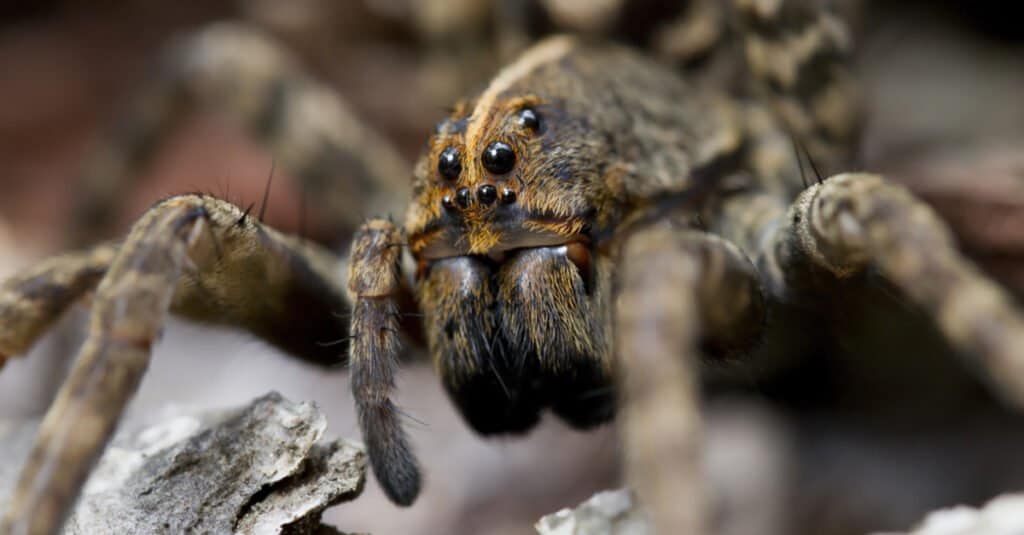Wolf spiders are robust, hairy spiders belonging to the family Lycosidae. There are various species of wolf spiders, but the most common type found in Arizona is Hogna carolinensis (Carolina Wolf Spider). This particular species is considered the largest of all wolf spider species in the United States, and in North America. This article explores what you need to know about wolf spiders in Arizona.
How to Identify Arizona Wolf Spiders

The Carolina wolf spider has an overall light brown color with dark brown patterning along its back.
©Macintyred / CC BY-SA 3.0 – License
Wolf spiders are large arachnids, easily identified by their huge size. Their body color varies from black and gray to brown, with dark marks along their legs and bodies. Like tarantulas, wolf spiders have thick, hairy bodies and live in burrows. The Carolina wolf spider has an overall light brown color with dark brown patterning along its back and a darker black underside. A male Carolina wolf spider can be identified by a distinct orange coloration on the sides of its abdomen.
Females are unique in how they carry their egg sacs on their backs, giving them a bulbous appearance. After the spiderlings emerge from their protective silk cover, they climb up to the dorsal side of their mother’s abdomen, where they remain for several weeks until they’re mature enough to fend for themselves. No other type of spider is known to carry their young on their back like wolf spiders.
Like most spiders of the Araneae order, the wolf spider has eight eyes –capable of detecting light and darkness. The wolf spider’s eyes are uniquely arranged into three horizontal rows. They have four small eyes in the bottom row, two medium-sized eyes in the top row, and two significantly larger eyes in the middle row. They’re known for their bright shiny green eyes, which is due to tapetum lucidum found in their secondary eyes, which reflects light rays through the retina. Due to this distinct feature, wolf spiders are known to have one of the best eyesights among all spiders. Their two large and prominent middle eyes distinguish them from similar-looking nursery web spiders and grass spiders, whose eyes are nearly equal sizes.
How Big Do Arizona Wolf Spiders Get?

Female wolf spiders generally grow up to 1.38 inches long.
©Will E. Davis/Shutterstock.com
Many genera of wolf spiders are relatively large, with bodies ranging in length from 0.4 to 1.38 inches (10 to 35 mm). The Hogna genus comprises the largest wolf spiders ever known. Among several Hogna species in the United States, the Carolina wolf spider (Hogna carolinensis) is the largest, with a body that can be more than 1 inch (2.5 cm) long. Adult females can reach 0.87 to 1.38 inches (22–35 mm) while adult males are about 0.7 to 0.8 inches (18–20 mm). Wolf spiders can sometimes be mistaken for tarantulas in Arizona due to their large size.
Where Can Arizona Wolf Spiders be Found?
Hogna carolinensis is found throughout the United States in habitats ranging from desert scrub to woodlands. These spiders are often found in Arizona Upland habitats, where their burrows are more obviously seen —especially in flatter and more open areas. Wolf spiders are typically active from March through October and are primarily nocturnal predators rarely seen during the day.
They are sometimes encountered crossing roads after dark because their green eyes reflect light, which makes them easy to spot. Being a nighttime hunter in the desert, the wolf spider may take shelter from the daytime heat and predators by hiding in abandoned rodent or reptile burrows, occupying rock alcoves, or digging up their own burrows. Wolf spider burrows can be differentiated from tarantula burrows by the turret of silk and twigs that extend vertically from the wolf spider’s hole.
What Do Arizona Wolf Spiders Eat?
As their name implies, wolf spiders are predatory spiders who roam at night hunting for food – like wolves. They are quick hunters that feed on insects such as flies, moths, ants, grasshoppers, earwigs, cockroaches, beetles, crickets, and other spiders. However, wolf spiders are solitary hunters, unlike wolves that hunt in packs. They differ from most spiders because they don’t spin webs to catch prey. Interestingly, some large female wolf spiders can take down bigger prey such as small reptiles and amphibians including frogs, lizards, and snakes.
Wolf Spiders Predators: What Eats Wolf Spiders?
While Carolina wolf spiders prey on several species, they may also find themselves preyed on by other animals, including amphibians, lizards, coyotes, elf owls, spider-eating birds, and various predatory insects, such as predatory wasps, and large arthropods like scorpions.
Are Arizona Wolf Spiders Dangerous?
Most spiders do not threaten people, instead, they play an important role in the natural population control of insects. However, the Carolina wolf spider is a venomous species, whose venom contains lycotoxins used to paralyze prey and for defense against infection from microorganisms present in their prey.
Though its bite is not considered dangerous to humans, this spider will bite if touched, threatened, or continually provoked. Symptoms of a wolf spider bite are; redness of the bite area, pain, swelling, and mild itching, which may last for days. They have fangs that can cause a tear in the skin when they bite. In some cases, the skin at the site of the bite may turn black. Despite these, a wolf spider’s venom is mild and is not considered medically important.
Wolf Spiders Lifespan: How Long Do Wolf Spiders Live?

Male wolf spiders typically have a lifespan of one year or less.
©iStock.com/CathyKeifer
Most wolf spiders live for one year. The male wolf spider presumably dies in the summer of its maturity, after its first mating. On the other hand, the female may live for another year after her first offspring.
The photo featured at the top of this post is © Will E. Davis/Shutterstock.com
Thank you for reading! Have some feedback for us? Contact the AZ Animals editorial team.






